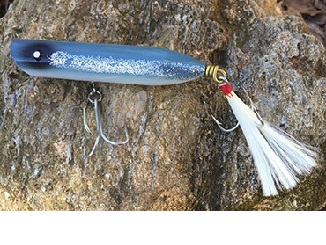 “We’re watching for one of three things,” a buddy told me. “If they are close enough, we might see the fish busting on top. More likely, we’ll see birds circling and diving. The third clue would be all the boats moving in the same direction.”
“We’re watching for one of three things,” a buddy told me. “If they are close enough, we might see the fish busting on top. More likely, we’ll see birds circling and diving. The third clue would be all the boats moving in the same direction.”
It felt odd not casting, even though we were marking bait and knew we were in the right general part of the lake. However, my friend had explained that drawing a fish up by blind casting was less likely than simply being less ready to move if a school popped up in the distance or cast to a fish that broke nearby. So we stood with Striper Strike-equipped rods in hand, watched, and waited.
We neither had to look far nor wait long. A huge school of striped bass came up all around the boat. In a quarter of a century since, I’ve never seen another major school come up right where I was sitting. We just had to start casting and jerking. Any direction would do. And it wasn’t long before we were doubled up on stripers.
It was late summer or early fall. I know that because it was near the beginning my first year of college, and my friend was a fellow student I only recently had met. That’s an important schooling time on many striper lakes, but defining a general “schooling season” would be tough at best because it varies so much from lake to lake. A lake’s mix of shad and herring species and how the stripers relate to them, the terrain, whether the lake stratifies, and how much water flows through it are just some of the factors that influence when surface schooling is most likely to happen on any given body of water.
Schooling locations, like the timing, vary enormously. Depending on the season and some of the same factors just mentioned, stripers might school near a reservoir’s dam, in a main-lake pocket or well up a creek or river arm. If you want to target schooling stripers, begin by gathering a bit of intel at a local bait shop. You don’t need spots. In truth, those change daily. You just need to know the general times when schooling tends to happen and any parts of the lake where schooling is common.
On the water, you can blind cast, especially if you know of a hump or point that the fish tend to school over. Often the stripers follow roving schools of baitfish, though, and a big school of stripers could push bait to the top almost anywhere. Typically, a better approach is to be ready with rods already rigged and to watch for the clues mentioned above. Find an area where baitfish are congregated or where you see a lot of seagulls that look like they are waiting for action and start watching.
Binoculars help for actually spotting breaking fish or for figuring out whether something you think you have spotted is what you think it is. Birds circling is a good thing. Circling and diving birds are much better and what you really want to spot. Those birds are diving for baitfish the stripers have driven to the top or struck and killed but missed grabbling.
When you run to schooling fish, always kill the engine well short of the breaking fish and never get too close, even with you trolling motor. It’s easy to scare them down. Beyond ruining the spot for yourself, little will make you less popular with other anglers than blasting into a school and spooking them.
In terms of lures for schooling stripers, a noisy, chugging Striper Strike is tough to top most days. Other good surface options include a Heddon Zara Spook or a Cotton Cordell Red-Fin, swam slowly across the surface to produce a wake. At times, the largest stripers will feed just below the surface schoolers, so have a couple of subsurface offerings, like a Heddon Swim’n Image or a Cotton Cordell Super Spot, ready as well. Schooling stripers are usually willing players, but at times they can get very picky about lure size. If they are schooling but not hitting your lures, try to get a look at the forage and do your best to “match the hatch.”
Maybe the most important warning about striper schools is that you need to have a few rods rigged and to be ready for mishaps. You’re apt to forget how to cast in the excitement, and anything can happen! If something does go awry, just grab another rod, keep fishing, and enjoy the excitement that school days bring.

